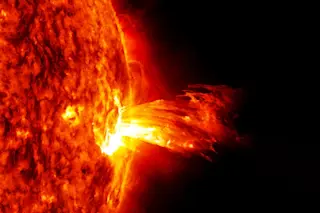The time has come for purists to celebrate the actual turning of the millennium, which arrives at the end of this month, 2,000 years after A.D. 1. Staring up at the dark, moonless sky this New Year's Eve, one might be tempted to imagine night travelers 10 or 20 centuries ago looking up at the very same sky and seeing the same stars. But that would be wrong. The night sky this month is quite different from the scene 1,000 years past. Tiny celestial motions, too small to notice from day to day, transform the heavens over time.
At midnight on December 31, blue-white Sirius, the brightest star at night, will dominate the southern sky, and yellowish Capella will be at or near the zenith. One millennium ago, Sirius was much lower, and Capella was nowhere near the overhead point. A few more 1,000-year-jumps back in time and Sirius was ...














